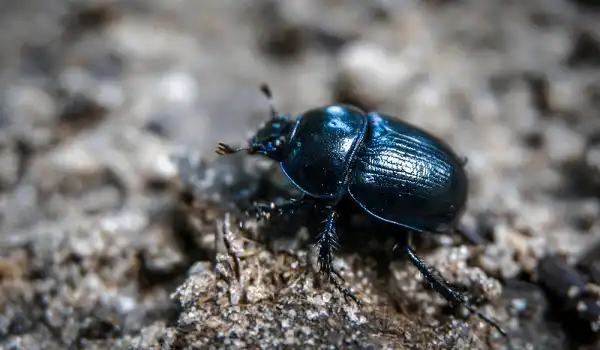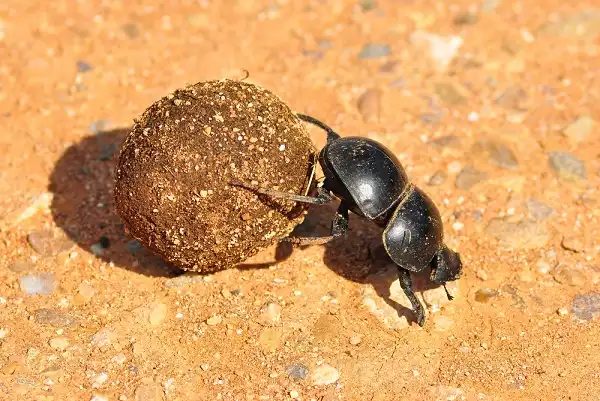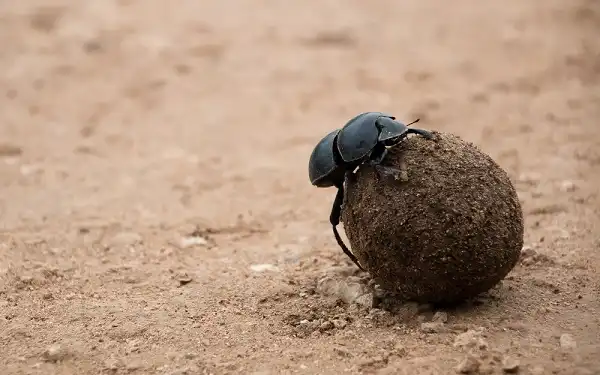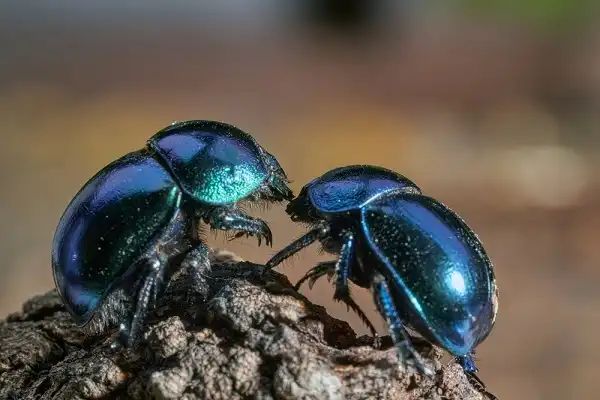The dung beetle is one of the most fascinating and beloved creatures in nature, with an impressive array of adaptations that allow it to thrive across many different climates. What makes these critters so special? Let’s take a closer look at their biology, behavior, and ecology to uncover exactly what sets them apart from other beetles. From their unique social structures to their essential role in nutrient cycling, dung beetles have some serious superpowers that make them incredible members of any ecosystem they inhabit.

Dung Beetle Description
The dung beetle is a small to medium-sized beetle that comes in many different shapes and sizes. They have between 6 and 9 segments on their antennae, and their heads are often covered with a small horn or projection. Coloration varies from species to species, but most dung beetles display shades of brown, black, yellow, or gray. Dung beetles possess powerful mandibles that they use to break down and carry food items like dung balls across great distances. Some species are even able to lift up to 850 times their own body weight! Most types of dung beetle also sport a set of wings beneath the hard exoskeleton which helps them fly further than other types of beetle.
Dung Beetle Habitat
Dung beetles can be found all over the world, inhabiting a wide variety of climates and habitats. From deserts and grasslands to tropical jungles, these hardy insects have managed to find ways to survive in many different environments. Due to their reliance on decaying materials such as dung and detritus for food, they are most commonly found in areas where there is plenty of organic material for them to feed on. This includes pastures, grasslands, forests, and even urban areas with compost heaps or other sources of decaying matter. Most species of dung beetle build their nests in the ground, forming tunnels or burrows beneath the soil surface where they can lay their eggs and store food items such as balls of dung.
The beetle will typically roll a single ball into its nest before settling down for the night. During the day these insects wander around searching for more food sources, often traveling long distances away from their nest sites. In addition to surviving in various terrestrial habitats, some species also live in freshwater bodies such as ponds or streams. These aquatic species feed on algae that grow on rocks or along stream beds. While not as common as their land-dwelling counterparts, these water-dwelling beetles do play an important role in nutrient cycling by helping break down dead materials at the bottom of aquatic ecosystems.
Dung Beetle Diet
The dung beetle diet consists primarily of decomposing organic matter, such as dung, decaying plant material, and insect carcasses. Some species feed exclusively on dung while others will eat a variety of different materials to meet their nutritional needs. Dung beetles are most commonly seen rolling balls of dung across the ground in search of a suitable nesting site. They use their powerful mandibles to break down the material for consumption and then store the nutrients within the ball for later use.
Dung beetles have been observed eating large amounts of dung within a short period of time, often taking multiple trips to gather enough food to sustain themselves and their young. Additionally, some species will also consume fungi that grow on decaying matter, as well as small insects and larvae that inhabit the same environment. In addition to providing essential nutrients such as protein and other essential amino acids, these sources of food also provide important trace minerals needed by the beetles for growth and development.

Dung Beetle Size
Dung beetles come in a variety of sizes, ranging from just a few millimeters up to over 40 millimeters. The average size for most species is around 10 to 12 millimeters in length, though some can be much larger. Their bodies can be oval-shaped or cylindrical in shape and are generally black or brown in color, although some species may possess bright colors or patterns on their exoskeleton. The size of the dung beetle often determines its ability to pick up and transport large amounts of dung and other materials, with larger species having an advantage over smaller ones.
Dung Beetle Lifespan
Dung beetles have a relatively short lifespan, living anywhere from several months to 2 years or more depending on the species. In general, smaller species tend to live for shorter periods of time when compared to larger species. The larval stage is typically the longest, lasting several months before pupation into adults. During this stage, larvae feed on dung and other decaying matter while developing into their adult form. Once they emerge as adults, they enter another period of feeding and mating which can last up to six months before dying. Adult dung beetles spend most of their lives searching for food sources or engaging in courtship rituals with potential mates. Toward the end of their lifespan, these activities slow down considerably as the beetles become weaker due to age and lack of nutrition. In certain regions dung beetle species have been used as indicators of environmental health due to their extreme sensitivity to changes in climate or land use practices such as deforestation or agricultural development.
Dung Beetle Behavior
Dung beetle behavior is largely determined by their stage of life. Adult beetles spend much of their time searching for food and potential mates. They use chemical signals to find each other in the dark and tend to congregate in areas where there are plenty of food sources, such as animal dung and decaying plant matter. Adult beetles also have interesting defensive behavior known as “balling” wherein they form a tight cluster by rolling up into a ball-like position when threatened. This defense technique has been seen employed by various species of dung beetles when confronted with larger predators such as birds or lizards.
In addition to defensive behaviors, dung beetles also exhibit remarkable navigation abilities enabling them to travel great distances across open landscapes while returning home after long journeys away from familiar territory. Studies have shown that some species can recognize polarized light patterns and use this information to orient themselves within unfamiliar environments, a remarkable feat given their small size and lack of advanced cognitive structures like those found in larger animals.

Dung Beetle Speed
Dung beetles are surprisingly quick and agile creatures, capable of moving at speeds up to 5 km/h. They are able to move so quickly due to their large hind legs which act as powerful spring-loaded pistons, allowing them to jump several times their body length with each stride. This impressive speed allows them to extract resources from their environment more efficiently than other species such as cockroaches and ants. Not only can dung beetles reach high speeds when on the hunt for food, but they can also reverse direction swiftly thanks to their ability to rotate their heads 180 degrees. This is essential when navigating narrow tunnels or crevices in search of nesting sites or potential mates.
Dung Beetle Hunting
Dung beetles are adept hunters, capable of finding and harvesting food sources with remarkable efficiency. To achieve this, they employ a variety of specialized behaviors including digging for buried dung, running in tandem with a mate to find suitable nesting sites or even using their powerful hind legs to jump several times their body length. They have also been observed rolling into tight clusters when threatened by predators such as birds or lizards – an effective defensive strategy. But their impressive hunting abilities extend beyond the physical realm: dung beetles possess remarkable navigation capabilities that allow them to travel great distances and return home after long journeys away from familiar territory. Studies have shown that some species can recognize polarized light patterns and use this information to orient themselves within unfamiliar environments, a remarkable feat given their small size and lack of advanced cognitive structures like those found in larger animals.

Conclusion
Dung beetles are one of the many fascinating creatures that inhabit our planet. With their impressive hunting and navigation abilities, they demonstrate an extraordinary level of intelligence and adaptation in order to survive in their natural habitats. From running with a mate to locate nesting sites to recognizing polarized light patterns while navigating unknown areas, dung beetles have adapted complex behaviors over time that ensure their success. Their remarkable feats make them a prime example of animal adaptation and evolutionary prowess – proof that despite their small size these insects can achieve great things! As such, it is important to acknowledge the vital role they play in ecosystems around the world and protect them from extinction.
Frequently Asked Question


